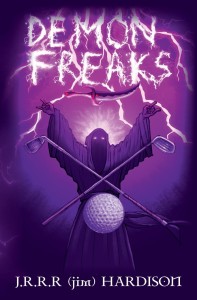
Book Review: Demon Freaks—J.R.R.R Hardison
Words By Zachary Sanfilippo
There are good books, bad books, and then there’s Demon Freaks by J.R.R.R Hardison.
Bing, Ron, Kaitlyn, and Meat are supposed to be studying for the SAT—if they don’t want to spend the rest of their days flipping burgers at McDonald’s, that is. But after their history teacher tries to kill them with an ancient dagger, studying is the last thing on their minds. Captured by evil golfers intent on summoning a world-destroying demon, the four must find a way to stop the coming apocalypse. In the night that ensues, toothy monsters from the dark, possession-by-sentient-dagger, and a covert McDonald’s paranormal investigation unit are only a few of the challenges they’ll have to face. And that’s not even to mention the SAT…
If the plot above sounds ridiculous, that’s because it is. Demon Freaks is a novel defined by its absurdity. Of course, many novels test the limits of convention and still succeed, sometimes wildly so. Those few novels which do, however, succeed because of the skill their authors bring to bear in telling the story believably—a skill which author J.R.R.R Hardison simply doesn’t display here. The novel lurches from one chapter to the next; Hardison clearly has an idea of where he wants to go but lacks the imagination of how to get there in an original, or even somewhat plausible, way. In all the cabins in all woods in the all world, for example, Bing and Ron’s evil history teacher stumbles into theirs…and then attempts to kill them for no reason at all.
The two are then rescued by their friend Kaitlyn, who comes crashing in with her car just in the nick of time. Further into the story, right as they are about to be devoured by supernatural monsters, Bing and Ron are saved by the appearance of a McDonald’s investigation unit. Each encounter seems to sink deeper into the ridiculous and contrived until, finally, the convenient revelation of the two’s parents as directors of that very McDonald’s unit makes the reader want to throw up her hands and ask exasperatingly: “And why wouldn’t they be?” It leaves the author’s universe feeling flimsy at the best of times; the sheer impossibility of the events which occur leaving the reader fatigued rather than immersed.
Demon Freaks’ biggest flaw, however, boils down to its style. There’s a mismatch between the market audience Hardison designs the plot to appeal to—kids—and the style he uses to bring that plot to life. Few adults will think it funny that the main villain is “Santa Claus,” but few kids will be able to endure far enough into the book to even meet him. Long, winding, description-heavy block paragraphs drag down the pace of the story and give readers every excuse to find something else to enjoy. The language, with vocabulary like “voluptuous” and “surreptitiously,” is simply not appropriate for young readers. Demon Freaks sways unsteadily on the boundary of young writing and adult writing, uncertain of which side it should land.
Lastly, what Hardison seems to bet heavily on to make his novel a success is its humor. It’s a smart strategy. Humor can often save a story from being damned, if done well. Demon Freaks tries to present itself as a humor-based book, but consistently, the novel’s humor misses the mark—sometimes disastrously. Perhaps this has to do with the difference in age between the target audience and myself, but the tears of laughter the author might have expected when revealing that the Golfers Association and “Santa Claus” were the main antagonists didn’t materialize.
The novel tries to achieve too many things at once—being both absurd and funny, appealing to both adults and children. In trying to be everything, it becomes a mess of half-things, which ultimately leaves its readers satisfied with nothing. With pared down language and jokes directed at its own absurdity, the novel might have achieved a self-aware humor that could have been clever while appealing to the younger audience Hardison seems to be aiming for. Furthermore, self-deprecating humor could have served to refresh the clichés Hardison employs, granting new license for their use. Unfortunately, the novel simply stumbles along, unsure of itself or its message.
All-in-all, Demon Freaks is an uncomfortable book to say the least. There’s an old cliché that writers only write for two things: for money or for the love of writing itself. Let us hope Hardison didn’t write this book for the first.